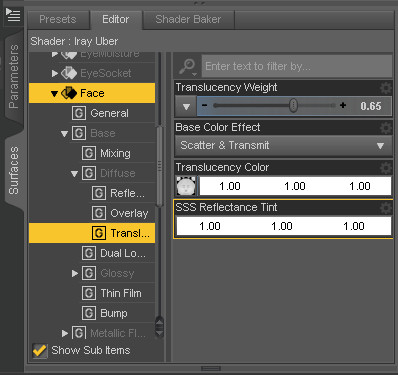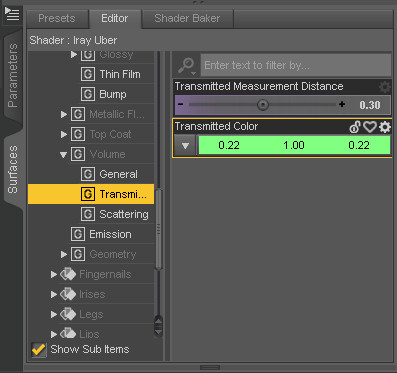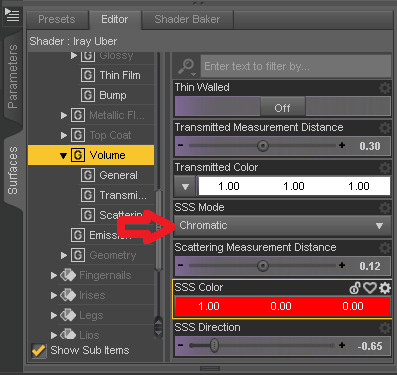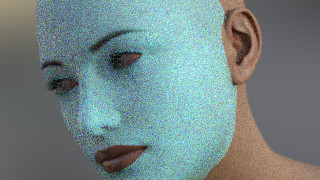looking for some help for the Blender plugin
I'm trying to help Thomas with materials and he did significant progress with the Blender plugin. But now I feel somewhat stuck with translucency and sss and the interaction between them. I mean the gross job is there and it works fine enough. But I feel we can do better so any help from anyone interested is great.
Below the links and part of the discussion reported for easy of reading.
http://diffeomorphic.blogspot.com/
https://bitbucket.org/Diffeomorphic/import-daz/issues/112/better-translucency-part-2-also-mixing
In my tests with iray it seems that sss doesn't work when traslucency if off. So sss needs some degree of translucency to do something. While translucency works fine even with sss off.
Also mixing sss and translucency colors seems to be a very messy thing. In some degree translucency seems to take precedence. That is, sss colors only appears clearly when translucency colors are white.
In this case blender doesn't match because the iray volume transmitted color is not considered by the importer. But honestly I didn't find any way to correctly handle it together with translucency. May be we can multiply it with the subsurface color of the principled shader if and only if the translucency colors are white. But this doesn't make too much sense to me either.



As for the chromatic mode it seems to be not documented at all in the official manual. But in my tests it takes the lowest precedence. That is, the chromatic color only appears clearly when the translucency colors are white and the volume transmitted color is white too.
Also, the chromatic color is the negative of what's specified in the in the input field. That is, if I specify red it comes out cyan (green+blue). Since it is not documented I don't know if this is a bug or its intended behaviour. For sure it doesn't make much sense.


Now I feel to translate all of this to the principled shader is impossible. The principled shader is designed to be simple and it works best alone its own way.
I believe when we are in sss mono mode the setup suggested in the previous post works fine enough. It inputs the same color both in the base channel and in the subsurface channel. I guess that's how mono is meant to be used in iray anyway.
As for the chromatic mode I'd give up with it. It is really messy. Then something will not match for sure but we always have time to improve things.


Comments
Hi I use Blender for stills only thus I use the teleblend script from "Mcasual"
I am not sure how the script by thomas builds blender nodes from
the Daz textures but the teleblend script completly ignores your Daz SSS settings and builds the node structures based on the Diffuse /Transparency/ specular/glossy.
You can add an Subsurface node via a mix Shader yourself
as I have done in the attached pic for the G8 male simply exported with his default texture as I am not at all invested in any G8 content beyond the starter essentials.
The problem I have encountered with using a Mix shader is that as you increas ethe SSS mix factor you begin to washout any image/photo based details such eyebrows ,freckles etc.
There is such a thing called a "scatter map" to control the distribution of the Scattering so it is not global on the entire face etc.
however I have never figured out how/where to plug it into the node hiearchy that teleblend auto creates.
Of course there is the powerful principled shader option to build your own skins from scratch in Blender, however I do not know how to get a principled shader surface to follow my figures UV mapping.
Unfortunately teleblender is very basic on materials. I believe the plugin by Thomas is far superior. Below the G8F rendered in DAZ Studio and Blender. They match quite fine since the plugin automatically translates translucency and sss for basic setups. Actually I believe the Blender materials are even better than the original. Plus cycles is faster than iray.
There are some complex cases where it doesn't match though and we're working on that. As for your question about Blender nodes you may give a look at the plugin setup it is quite good.
DAZ Studio rendering 1 minutes 51 seconds
Blender rendering 43 seconds
Speaking of Lightwave, the 2018 version seems really good. But finally it goes toward what Blender already has or will have such as the principled shader and real-time PBR in the viewport (eevee). I don't know what's the difference with 2015 since it's some time I don't use Lightwave. I really loved it by the way.
https://www.youtube.com/watch?v=wKJGFm4DDls
As for the scatter maps I have no experience with them but I'd try to plug them in the principled subsurface channel and see what happens.
Hey I just noticed this thread. As one of the forums blender fans and a big shaders and materials tinkerer I'd love to throw in my 2 cents. On the Iray side I have a pretty good understanding of how SSS and translucency work. Iray actually operates in much the same way that Luxrender does. That is, there is no dedicated SSS shader instead it uses translucency and volumetrics. This is technically more "physically accurate" than an SSS shader, like cycles has, but significantly slower (and in iray's case occasionally a bit more buggy as well)
In converting from Iray to Cycles that means there are 2 options. 1) keeping things more 1 to 1 and setting up the shader that matches the Iray setup for SSS and adds translucency + volume. This would be more likely to work in all situations, including things like non skin material with a bit of volume scatter or what have you. On theother hand It would be a lot less optimized, The volumetric sss is way slower
2) cheat a bit. If possible make it so that if "thinwalled on" is on then translucence is used but if the material is set to "thinwalled off" proper SSS is used instead, as this is functionally what is happening in Iray just without the benefit of a dedicated SSS shader. Mind you, I don't know how easy it would be able to set something up that switches between SSS and translucence in the way I described.
@j cade thank you for your reply.
If I understand correctly what you mean that is the actual implementation used in the importer. It is very efficient and it works for most cases. What I have trouble with is to find a way to correctly handle the sss color together with translucency colors. And the sss chromatic mode. So to match iray in cycles when these features are used. Any idea is appreciated and I'll gladly do tests to see if it works.
Actually I'm working to match specularity both for bsdf and principled conversions, it is coming out quite fine too. Please feel free to jump into any discussion you like at the plugin site. There you'll find more technical data to work with that I'm not going to repost here because it would be a double work.
https://bitbucket.org/Diffeomorphic/import-daz/issues